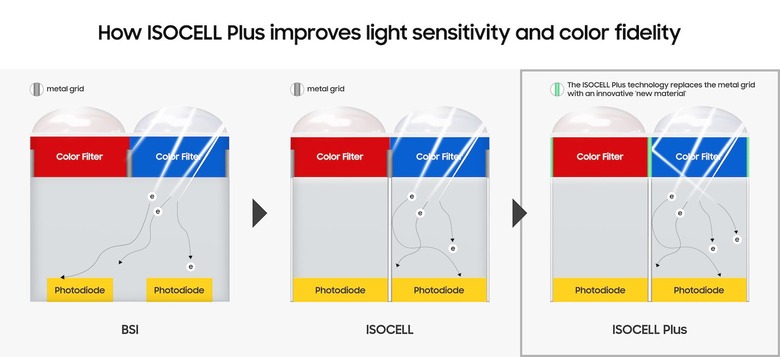This New Samsung Camera Could Restart The Smartphone Megapixel War
Samsung smartphone cameras are about to get a big improvement in low-light performance, with a new image sensor technology, ISOCELL Plus, promising better color and less blow-out. The improvements are likely to be visible in Samsung's next-generation smartphones but, since the company also provides CMOS image sensors to other phone-makers, won't just be limited to upcoming Galaxy S and Galaxy Note handsets.
ISOCELL Plus relies on a fairly straightforward idea. If you can capture more light than older sensors previously managed, and isolate that light to the individual pixels while minimizing overspill, you'll get a brighter end result. You'll also get more accurate colors.
The first iteration of ISOCELL, back in 2013, introduced barriers between pixels. Where BSI, or backside-illuminated, sensors had no divisions between the individual photodiodes, Samsung's sensors implemented a metal grid that separated each photodiode. That physical barrier cut down on color crosstalk, while also allowing each pixel to take in more light.

ISOCELL Plus keeps that concept of separating the photodiodes, but switches up the material used to actually do that. Instead of metal grids, Samsung is using a "new material" developed by Fujifilm. That, it's said, demonstrates less of the optical loss that metals can cause – as they either reflect or absorb the light coming into the CMOS image sensor – and thus more of that light makes it to the photodiode.
It's the first time a company has used the Fujifilm technology commercially, and details about it are still slim. Indeed, neither firm is saying exactly what the "new material" actually is.
However, they're more forthcoming about why you should care about it. ISOCELL Plus shows up to a 15-percent increase in light sensitivity, Samsung claims, along with higher color fidelity. It may also reignite the smartphone megapixel race in the process.
While phones went through a period of chasing higher and higher megapixel counts, most eventually settled back on more restrained numbers – around 12-megapixels – for reasons of realism. Squeezing more megapixels into such small sensors led to poor low-light performance and plenty of crossblur. Even though the images captured may have been higher resolution than before, they weren't necessarily any clearer.
ISOCELL Plus, though, allows for smaller pixels without a loss in overall performance, Samsung claims. Indeed, it's saying 0.8-micrometer and smaller pixels are now feasible, for 20+ megapixel cameras. In contrast, the main camera on the current Galaxy S9 uses 1.4-micrometer pixels.
Samsung isn't saying exactly when it expects the first phones using the sensors to show up on store shelves, though it will be demonstrating ISOCELL Plus this week at Mobile World Congress Shanghai.
